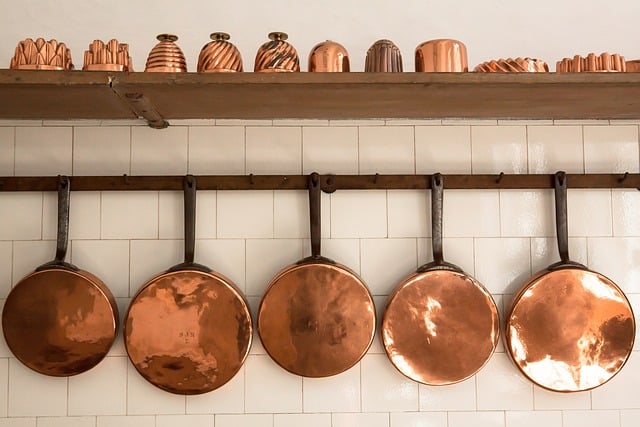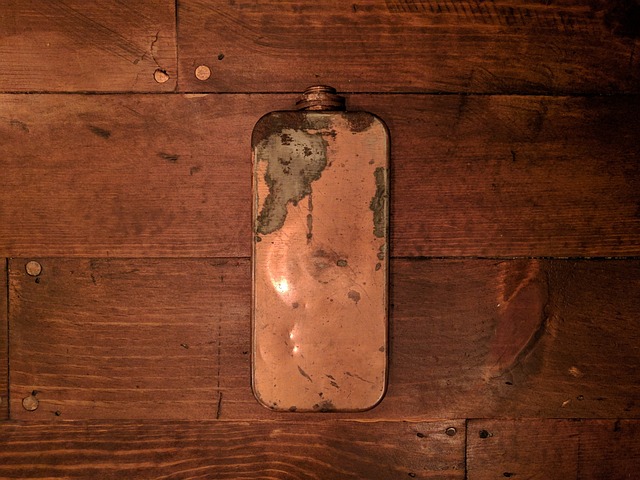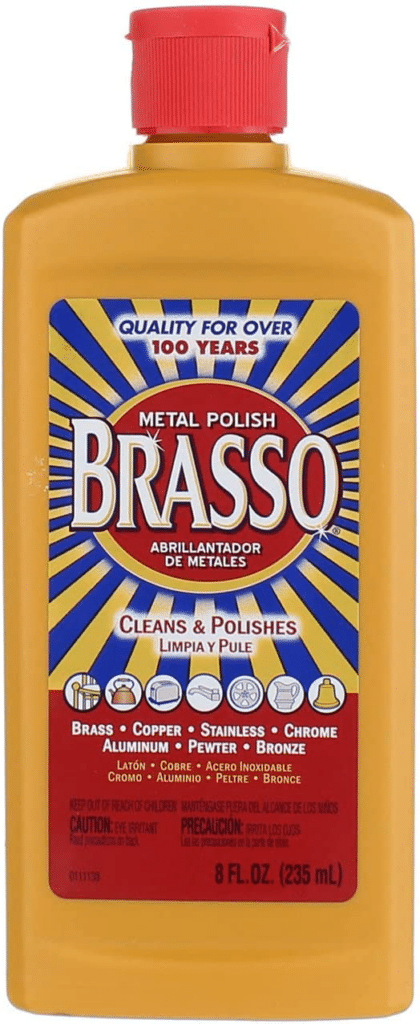Introduction – Copper Pieces
Don’t throw away that copper item! You can make it look new again. Copper is a much-loved material in kitchen and decorative ware, and jewelry-making. The materal is good for making beautiful and unique pieces, from cups, jars, bath tubs to necklaces, rings and bracelets. Copper is malleable and easy to shape, making it ideal for intricate designs. Copper items can last a lifetime with minimal wear when properly cared for.

Copper Reacts With Oxygen To Form Patina And Over Time Will Corrode
Just like iron rusts, copper rusts, too – though we don’t call it “rust” and the process is a bit different. Iron rust is a form of oxidation that affects iron and iron alloys, such as steel. Iron rust is a reddish-brown material that forms when iron is exposed to oxygen and moisture. Iron rust can cause metal to weaken and can eventually lead to its destruction.
Two things happen to copper:
Copper does not oxidize like iron and does not create the reddish brown material. Instead, copper will react with air to form a greenish layer called “patina“. But it doesn’t do it in a single step. The patina is formed via a series of chemical reactions. During this process, the colors of copper will change. These reactions slowly increase the proportion of oxygen to copper over time. There are 3 reactions that happen and the results are all different.
4Cu + O2 → 2Cu2O (reddish color): This reaction describes the oxidation of copper (Cu) in the presence of oxygen (O2) to form copper(I) oxide (Cu2O), which has a reddish color. Each copper atom is indeed associated with one oxygen atom in the resulting compound.
2Cu2O + O2 → 4CuO (blackish color): This is another oxidation reaction, this time of copper(I) oxide to copper(II) oxide (CuO), which is black. In the resulting compound, each copper atom is associated with one oxygen atom, just like in the previous reaction, not increased.
2CuO + CO2 + H2O → Cu2CO3(OH)2 (patina, greenish color): This reaction describes the formation of copper(II) carbonate hydroxide, also known as malachite or the patina seen on weathered copper and bronze. In this compound, each copper atom is indeed associated with two oxygen atoms directly from the oxide ions (O2-), but the full compound also includes additional oxygen atoms that are part of the carbonate (CO3) and hydroxide (OH) groups.
Copper will corrode. The immediate effect of patina is a stabilization because no more oxygens are added. The longer term effect is that the structure of copper, especially if theres water and salt effects, will degrade over time. Copper corrosion is the gradual degradation of copper due to a reaction with its environment, such as air or water. This can be seen in copper pipes that over very long times corrode so much that holes develop and the pipe breaks.

Copper rust isn’t as problematic as iron rust because it doesn’t cause the same type of corrosion. However, it can still damage copper surfaces over time by creating a patina that makes the metal look dull and discolored. Fortunately, there are a few simple ways to remove copper rust and keep your surfaces looking new.
How To Identify Copper Rust, And What Are The Symptoms?
There are a few ways to identify copper rust or patina. Copper patina can be identified by its greenish color and rough texture, which will usually form over time as copper is exposed to air. Copper corrosion can be identified by its reddish-brown color and flaky texture. Both patina and corrosion can be identified by a qualified professional, such as a metal expert or an engineer.
Copper rust can cause several problems. First, it can weaken the structure of the copper surface. This can lead to cracks and, eventually, failure. Second, it can cause the copper to lose its luster and develop a dull appearance. Finally, it can also cause staining and discoloration of surrounding materials.
If you suspect that you have copper rust, it is important to take action immediately. Copper rust can cause serious damage to your copper surfaces if left unchecked. In some cases, it can even lead to structural problems. Copper rust can be ugly and damaging, but you can control it with quick action and proper care.
Two Ways To Remove Rust And Corrosion From Copper
We will talk about two ways to remove the patina from copper. The first way uses an acidic solution and salt as an abrasive. The second uses a commercial product designed to remove the patina.
Method 1: Acid With Salt Method
1. Make a weak acid solution by mixing half a cup of distilled white vinegar with two teaspoons of plain table salt. Stir the mixture until the salt is completely dissolved. A weak acid solution with vinegar and salt helps to break down the patina on the copper, making it easier to remove.
2. Put a copper item with patina halfway into the solution and leave it for a few seconds until the patina comes off. Submerging for a few seconds will help to remove any patina from the surface
3. Using a toothbrush, scrub the top of the asset for five to ten seconds to remove any patina. Scrubbing the top of the copper with a toothbrush helps to further remove any remaining patina.
4. Rinse the top under running tap water for one to two minutes to neutralize the acid and remove any residue. Rinsing the top of the copper with running tap water helps to neutralize the acid and remove any residue.
5. Gently pat the top dry, but leave some water on it for the next step. Gently patting the top of the copper dry helps to remove any excess water, but leaving a bit of water on the copper helps to keep the surface moist.
6. Dry the top completely by using a hairdryer with some heat for two to three minutes or by putting it on a dehumidifier or near a fan for 15 to 20 minutes. Finally, drying the top of the copper completely helps to prevent any corrosion or tarnish from forming on the surface.
Method 2: Commercial Polishing Cloth And Polish
A metal polishing cloth is a type of cloth used to clean and polish metal surfaces. It is usually a soft, lint-free cloth made from cotton or microfiber, and is often impregnated with an abrasive or polishing compound. It is used to remove tarnish from silver, brass, and other metals. Here we’ll take you step-by-step on how to use one.
1. Gather all the materials needed: Cape Cod metal polishing cloths, Brass-O, silver polish, Q-tips, gun cleaning picks, and microfiber cloth.
2. Wipe the Cape Cod metal polishing cloths onto the copper and then use a microfiber cloth to buff it out. Cape Cod polishing cloths are specifically designed for cleaning copper, so they are the best choice for the initial cleaning. Buffing the copper with a microfiber cloth helps to remove any remaining dirt and grime.
3. If there are still some stains that cannot be removed with Cape Cod, use Brass-O. Wipe it onto the top and then use a microfiber cloth to buff it out. Brass-O is a type of metal polish specifically designed for brass and copper. It is used to remove tough stains, dirt, and grime from these metals. Wiping it onto the top and then buffing it out with a microfiber cloth helps to remove any remaining residue.

Brasso will really work – it will remove the copper patina from the surface leaving a greenish black residue on the microfiber cloth. The copper will be much shinier after.
4. If needed, use silver polish, which works just as well on copper and brass. Wipe it onto the top and then use a microfiber cloth to buff it out. Silver polish is an effective way to remove tough stains from copper and brass. Wiping it onto the top and then buffing it out with a microfiber cloth helps to remove any remaining residue.
5. Use Q-tips and gun cleaning picks to get into the nooks and crannies of the copper. Wrap a microfiber cloth over them for extra cleaning power. Q-tips and gun cleaning picks are ideal for getting into the hard-to-reach areas of copper. Wrapping a microfiber cloth around them provides extra cleaning power, allowing for a more thorough clean.
6. When finished, wipe off any remaining product with a clean, dry microfiber cloth. Wiping off any remaining product with a clean, dry microfiber cloth prevents any product residue from being left on the copper. This helps to protect the copper and keep it looking its best.
Wrapping Up
The warmth and richness of copper are attractive to many, and the metal can help make pieces stand out. Copper is also quite affordable, making it accessible regardless of budget. It’s important to remember to care for copper pieces properly, as it can tarnish quickly if left exposed to moisture or air. Regularly polishing your pieces and keeping them away from moisture will help keep them looking bright and beautiful for years to come.
In conclusion, there are a few effective methods for removing rust from copper. The lemon juice with baking soda method is a safe and easy way to remove light rust, while the lemon juice with baking soda and vinegar with salt is a more powerful option for tougher rust stains. Regardless of your chosen method, rinse the copper thoroughly and store it in a cool, dry place. With proper care, your copper will remain beautiful for many years!
